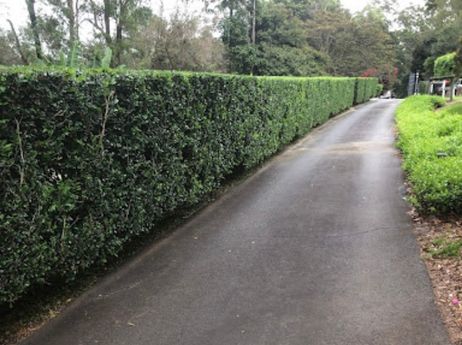Does Trimming Hedges Promote Growth
Since hedges are living plants, they have a wide range of responses to their surroundings. Some beneficial and some damaging. Just about all Native Australian hedges are extremely resilient during all seasons, especially in summer time you’ll notice that they just take off in growth. In saying that, there is a right and wrong time for trimming hedges. Throughout this blog we hope to provide you with enough helpful information so that you are aware of the benefits and drawbacks to hedge trimming.
When trimming hedges you should always aim to do this around early spring to late summer, this is known as the growth period when the sun is out, there’s plenty of nutrient-rich rain and the temperature is more comfortable for hedges and shrubs. By allowing for a more equal renewal, trimming a hedge into a wedge shape with a wider bottom will cause it to thicken. Use organic fertilisers to promote plant and root growth and trim down the top of the hedge to direct growth and additional sunlight toward the sides of your hedge. Trimming during the winter months is still something that can be done but take note, it’ll take the hedge longer to recover and start the re-growth process.
Weather, soil, and the immediate environment have an impact on all plants. When a hedge experiences uneven growth, which might be brought on by malnutrition or invasive species, it becomes thin and should be thoroughly assessed by either yourself or a professional to determine what can be done to bring it back to life.
How Should My Hedge Be Trimmed To Promote Growth?
Trimming your hedge at the proper time of year to promote even growth is essential. Redirecting growth hormones to established areas by cutting back on new growth in the spring will result in a thicker hedge in the summer.
Trimming in late autumn or early winter can help the cytokines (Cytokines – Hormones associated with plant growth) to perform their magic over the chilly months if you want to boost root growth.
Your shrubs will concentrate on producing leaves and buds once the weather warms up, so you’ll want to control their growth there when the time comes. Mid to late spring and early summer trimming can help balance out the natural sprint for the sun that all hedges endure.
Making sure that the plant’s base is wider than the top of the hedge is crucial, this provides the hedge with a strong solid foundation. This avoids the usual cause of hedges becoming thin at the bottom—new growth shading the lowest part of the plant from the sun. If you trim a hedge into a cube shape in the early summer, by the late summer you will have a plant that is considerably broader on the upper half.

Regular trimming is also a great way to promote and stimulate new growth and also maintain the integrity and health of the hedge. Through regular trimming the hedge is constantly being groomed and taken care off, for example, through the regular removal of dead leaves, dead branches or sticks, removal of insect buildup on leaves and possible diseases this essentially cleans the hedge and stimulates new growth, the same way we regularly wash our hair, the cleaner your hair the more chance of it growing. Also through regular trimming the old, dead or possibly damaged leaves and sticks are removed each trim, therefore providing the space, room and light to boost growth.
In short, frequent trimming during the warmer months will promote exceptional growth and improve the quality and health of the hedge whilst simultaneously helping the hedge thicken up and create a wonderful, sharp looking hedge like in the image on this page.
We Accept





